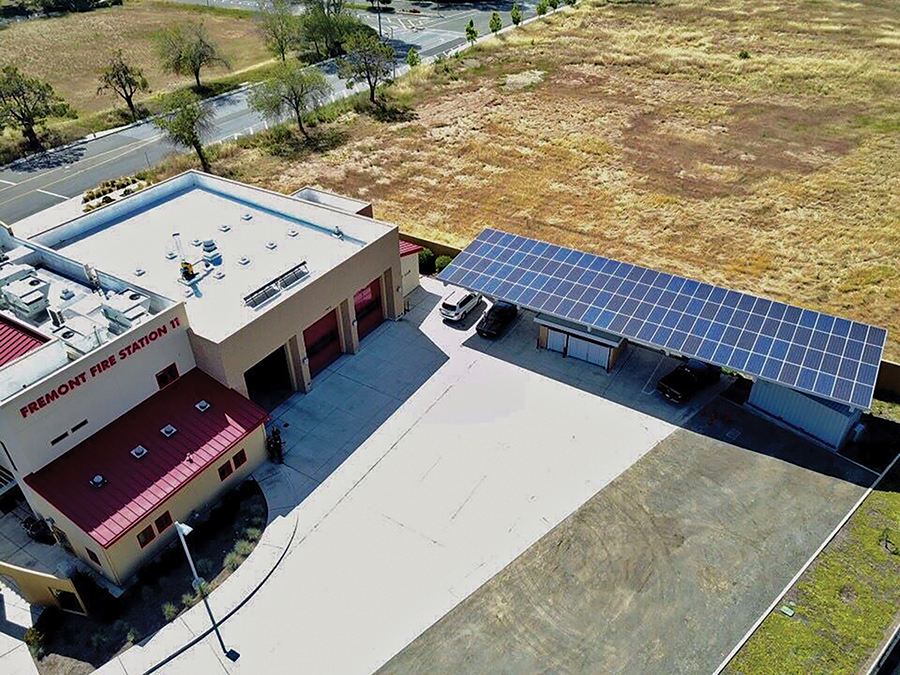
Fire Station 11 is one of three in Fremont to have been equipped with solar-powered microgrids, saving on energy costs and reducing greenhouse gas emissions. Photo courtesy the City of Fremont.
Self-reliance is an appealing concept, evoking the image of pioneers taking control of their own destiny, but it can be difficult to achieve in our modern world. The electrical grid which connects large power sources to homes, businesses, and community facilities serves everyone, but when it fails, it fails everyone. Recent planned and unplanned power outages across the state have had many residents asking themselves, “What would it take to be self-sufficient and independent of the grid?”
The quick (and literally dirty) answer has often been diesel backup generators. Although diesel generators (and cleaner propane models) have become a standard for emergencies, downsides include accidental fires and limited usability during longer disruptions. A more sustainable option, in many ways, is a microgrid.
Microgrids consist of a power source connected to battery storage; when energy isn’t wanted all at once, a controller system moves energy into and out of the batteries as needed. The power source can be a generator, solar panels, or fuel cells. Because microgrids produce power close to where it is used, instead of relying on large power generators many miles away, they don’t need large transmission lines. As a result, a distinctive feature of a microgrid is its self-sufficiency. While most microgrids are normally connected to the main grid, during outages they can be cut off — “islanded” — from the main grid and operate on their own, often for extensive periods of time.
Microgrids aren’t new — for years, “off the grid” homes and facilities have used wood or propane for light and heat because they were too distant from utility power lines. Large institutions such as colleges and hospitals have often relied on their own power generation and distribution systems, usually powered by fossil fuels. But microgrids have evolved, and the increasing inclusion of solar panels, storage batteries, and fuel cells means they can have both a smaller carbon footprint and lower energy costs. Microgrids can achieve additional environmental benefits by incorporating sophisticated software to manage the balance between power generation, storage, and use. These technological advances now allow individual homeowners to create a one-home microgrid, although it might not supply all their needs in an emergency.
Multiple configurations of power sources and storage make it possible to think outside the box when setting up microgrids, or in some cases, inside a different box. BoxPower, a microgrid designer and manufacturer, packages its microgrids like kits in shipping containers, making them a good fit for situations where standard utility installations are impractical. The Grass Valley firm has created microgrids for a remote research station near Truckee (where hardening utility lines would have cost the local utility three times as much) and near Yosemite in the tiny community of Briceberg (where the microgrid will replace PG&E infrastructure vulnerable to wildfires).
Microgrids can also add permanent protection against power outages to vital community services. Using a 2015 California Energy Commission grant program for critical facility microgrids, the City of Fremont and Fremont-based firm Gridscape installed solar-powered microgrids at three city fire stations. Gridscape’s investment will be paid back over 10 years by a power purchase agreement, which allows the city to buy the solar power at a negotiated price, saving on utility bills.
To ensure there are no fire response interruptions in an emergency, the project’s software ensures that 25 to 30 percent of battery storage is available at all times, providing three hours of power if no solar is being generated, and up to 10 hours with solar input. Fremont Sustainability Manager Rachel DiFranco said, “We still have the diesel backup generator, but we expect to use it very briefly — only if the batteries are exhausted and we aren’t generating solar right then — which should extend our generator availability considerably.”
DiFranco reported that power purchasing agreements and advances in controller design are making microgrids more affordable for public agencies. Gridscape is currently working with other communities on similar critical facility projects, and recently received a loan guarantee from the Bay Area Air Quality Management District after a technical analysis by the agency. It’s one of a growing number of firms installing microgrids around the Bay Area, from wastewater treatment plants in San Leandro and Santa Rosa to a private development in Healdsburg.
What microgrids provide in many of these examples is not total self-sufficiency, because they often draw from the main grid except in emergencies, and sometimes depend on backup generator power. Rather, it’s resiliency, the ability to keep food or medications cold, medical equipment working, or safety lighting on.
CleanCoalition, a nonprofit working at maximizing the use of renewable energy, consulted on the Fremont fire station project. Executive director Craig Lewis described how another CleanCoalition microgrid project adds to the resiliency of the entire community. Valencia Gardens, a 260-unit housing development in the middle of the Mission District in San Francisco, serves low-income and elderly residents, two groups who are particularly at risk during power outages. When islanded, the Valencia Gardens microgrid will supply power according to a tiered system, with essential functions such as refrigeration and medical equipment powered continuously. Other needs would be powered some or most of the time depending on priority.
Lewis argues that a tiered process for prioritizing power use can also guide decisions on who pays for that power. If a fire station is designated as a Tier 1 facility, and its Tier 1 priority use for power is dispatching responders, the whole community benefits from that service and Lewis feels it should eventually be supported by utility ratepayers. A different calculation could be made for a Tier 2 facility, such as a community shelter, which has both Tier 1 needs (heat or air conditioning) and Tier 2 needs such as restroom lights or meal preparation.
How microgrids, public or private, intersect with regulated utilities is an evolving picture. Recent California Public Utilities Commission and Federal Energy Regulatory Commission decisions have put more responsibility on the regulated utilities to develop and integrate microgrids for greater resiliency. BoxPower’s Briceberg microgrid is one of 20 remote grids that PG&E plans by 2022. Many advocates for microgrids believe that more changes should be required. For example, a study on creating a microgrid for all City of Berkeley facilities concluded that a major barrier to such a plan is the current requirement for any power traveling across a roadway to be carried on utility wires.
Pressure for additional regulatory changes will grow as the potential of microgrids becomes better understood, either in standalone projects or as part of sub-regional community plans such as those designed by CleanCoalition for southern San Mateo County and the North Bay. Reduced power costs, an improved carbon footprint, flexibility, and greater independence from the main grid promise microgrids a starring role in meeting regional energy needs.
Leslie Stewart covers air quality and energy for the Monitor.

